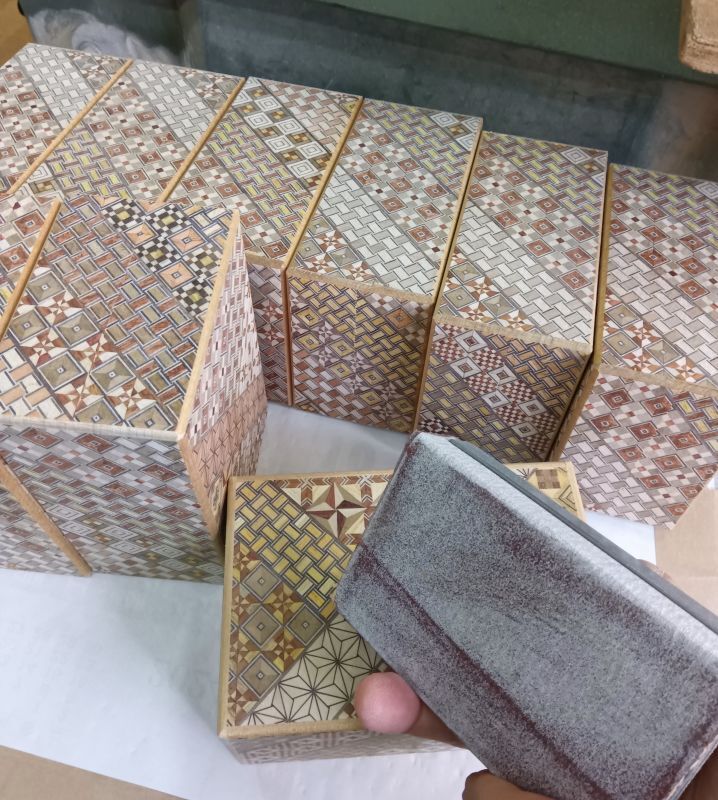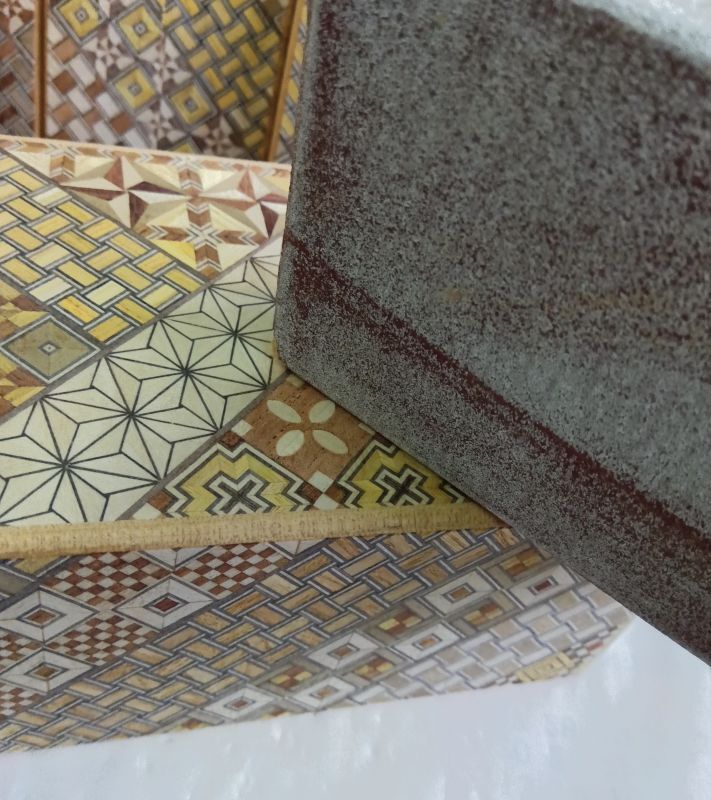Sandpaper and handmade
The photo shows the finishing process of the 5 sun 21 steps Japanese puzzle box. After rounding the edges of the box, I manually sand down any small protruding parts of the side panels one by one using sandpaper. The most crucial thing to be careful about during this process is not to sand off the Yosegi parts. The Yosegi sheet is glued onto the side panel (or top panel) and is very thin, about 0.15 to 0.2 mm thick. Therefore, it can easily be sanded off with just one stroke of the sandpaper. This process varies for each individual box, so it can't be done uniformly with woodworking machines. That's why I perform it by hand.
As you might expect, there are many processes in puzzle box making that are done by hand. These steps are necessary to create high-quality Japanese puzzle boxes and showcase the craftsman's skill. This is also why these puzzle boxes can't be mass-produced by machines.
To make many Japanese puzzle boxes, I need to produce lots of components, and this process is done using woodworking machines. This is essentially parts manufacturing. Then, the assembly work, attaching the moving panels, and finishing processes like the one in the photo are all done by hand. I consider the most crucial and delicate task to be attaching the moving panels (Aruki). The unique movement of the Japanese puzzle box - that simple, gentle wooden mechanism - is born from this process. To achieve just the right movement in the mechanism, a craftsman will adjust each box's mechanism many times.
This sandpaper work is the final manual process before painting and is an important step in making the box look more beautiful. At this time, I also check for any external flaws in the box. Very rarely, the box corners may chip during the process of rounding the edges (done by woodworking machines). Also, once the box is painted (finish coating), it becomes impossible to correct any issues with the Yosegi or the box surface. So, I simultaneously check for any peeling or damage to the Yosegi-sheet.
To be honest, when I'm making a large number of boxes, this work becomes quite hard work😂 But I do it meticulously to create beautiful boxes!😁
As you might expect, there are many processes in puzzle box making that are done by hand. These steps are necessary to create high-quality Japanese puzzle boxes and showcase the craftsman's skill. This is also why these puzzle boxes can't be mass-produced by machines.
To make many Japanese puzzle boxes, I need to produce lots of components, and this process is done using woodworking machines. This is essentially parts manufacturing. Then, the assembly work, attaching the moving panels, and finishing processes like the one in the photo are all done by hand. I consider the most crucial and delicate task to be attaching the moving panels (Aruki). The unique movement of the Japanese puzzle box - that simple, gentle wooden mechanism - is born from this process. To achieve just the right movement in the mechanism, a craftsman will adjust each box's mechanism many times.
This sandpaper work is the final manual process before painting and is an important step in making the box look more beautiful. At this time, I also check for any external flaws in the box. Very rarely, the box corners may chip during the process of rounding the edges (done by woodworking machines). Also, once the box is painted (finish coating), it becomes impossible to correct any issues with the Yosegi or the box surface. So, I simultaneously check for any peeling or damage to the Yosegi-sheet.
To be honest, when I'm making a large number of boxes, this work becomes quite hard work😂 But I do it meticulously to create beautiful boxes!😁

